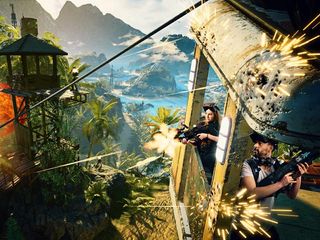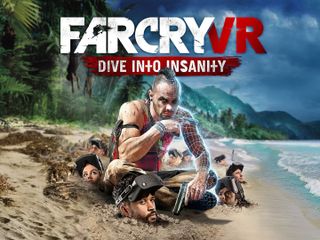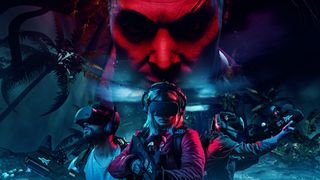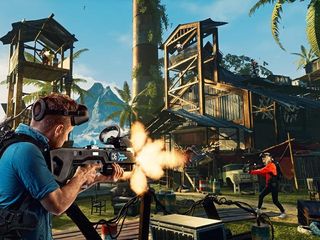Far Cry VR interview: Creating unique gameplay with modern immersive tech
Zero Latency's own brand of VR arcade provides a unique setpiece to escape Rook Islands.


When Ubisoft announced Far Cry VR: Dive Into Insanity at Ubisoft Forward last week, it surprised quite a few gamers. They were even more surprised to learn that the experience was exclusive to VR arcades, specifically Zero Latency arcades, which specialize in what it calls Location-Based Experiences (or LBEs, for short). Zero Latency runs these LBEs at 45 across the world and specializes in games that pair up to 8 people together in a large 2,000 sqft playspace, giving them the ability to free-roam a giant virtual environment.
So how does a location-based in-person experience work in a world affected by COVID-19, and what can free-roam VR bring to the world of Far Cry? We had a chat with Zero Latency CEO, Tim Ruse, about the development of Far Cry VR, how VR arcades work going forward, and how Zero Latency could provide a compelling way to experience the story of Far Cry 3 that we might not be able to get at home.

It's time for a new type of vacation.
Vacation didn't pan out as expected. Fight Vaas's band of insane henchmen as you escape Rook Islands with up to 7 friends.
Exploring modern VR tech

Nick Sutrich, Windows Central: Arcades used to exist, at least in part, because powerful gaming hardware was too expensive to have at home. Do you see virtual reality in a similar position right now, or are VR arcades like Zero Latency more designed to offer a unique experience that you could never have at home?
Tim Ruse, CEO of Zero Latency: Zero Latency strives to provide a really social experience that you want to go out of home for and a technology experience that you simply can't get at home. The hardware would be too expensive, plus the space you get at Zero Latency isn't something you could get at home. Some of our players travel up to a kilometer walking around the game.
Some players that experience Zero Latency first before they go into a VR arcade or buy their own hardware do get a bit spoiled by Zero Latency because you can have such a fantastic free-roaming experience. It's very different from being tethered to a computer or only being able to walk one or two steps in any direction, which can constrain you quite heavily on what you can do with the content.
Tell me a bit about the tech used at Zero Latency. How did the design come about, and how do you work with hardware partners to build the experience?
We use a Windows Mixed Reality system with SLAM (simultaneous localization and mapping) tracking, plus some of our own 'secret sauce' to make that work. At a larger scale, it works really robustly. We use backpack PCs manufactured by HP that serves a fair bit of grunt. We use HP Reverb headsets that connect with the backpack PCs and communicate to our central systems wirelessly. We have our own controller, we call it. It's essentially a gun prop that allows users to be painted into the experience. Instead of having little controls in your hands, you have this sort of great, chunky weapon with two touch points that anchors you into the experience.
Get the Windows Central Newsletter
All the latest news, reviews, and guides for Windows and Xbox diehards.

Backpack PCs sound like they could be pretty fragile. I imagine too much action could mess up fans or maybe dislodge RAM. Have you experienced that happening and, if so, what sorts of improvements have you worked on over the years?
We've worked with HP to sort of help them develop (the backpack units). It features a pretty hard clamshell that's pretty robust, and the heatsinks are really effective in keeping it cool. We initially had some plastic parts that eventually broke and were replaced with metal parts, which strengthens the units quite a bit. We encourage the operators to be putting them on and off the players. They are pretty easy to get on and off, and you'll find people are pretty gentle, but you don't want to be dropping them a lot.
It's essentially a lot of laptop components built into a different form factor. Early on, we made our own backpack PCs from desktop PC components, which was fraught with danger. It didn't take much of a knock to jiggle and disconnect the RAM, so we were really glad we found some hardware providers that would help us build a better system.
How do upgrades work at Zero Latency? Do you often upgrade to the latest components, or do you find that the current custom-built solutions work best for the experience?
We definitely try to keep abreast of the latest hardware updates and incorporate them as it makes sense for the platform. That includes new backpack PCs as well as new headsets, like the HP Reverb G2, which is a pretty cool looking unit. The actual jump from the older-generation headsets to the original Reverb, which we use now, was incredible. You could actually read text and read a menu, which was pretty amazing at the time. The nature of the pixel density has completely gotten rid of the screen door effect, which has been a significant improvement over the years.
Making Far Cry a little more personal
Moving into Far Cry VR: Dive Into Insanity, tell me a bit about how the project came to be. Did Ubisoft approach you? Was it the other way around, maybe a bit of both?
A little bit of both. We've been in contact with those guys since started the company in 2015. It was about finding the right time for our business, the technology being at the level where we can provide an experience Ubisoft would be comfortable with using a location-based setting. We've been sort of kicking it around with them for about a year off and on, and we settled on the Far Cry IP. It's such an iconic franchise, and I'm a big fan of it.
Far Cry is a huge property and seems like it could be an important title for VR, especially since it seems like Vaas is the most popular Far Cry villain. How was Far Cry VR developed specifically with Zero Latency in mind?
(Far Cry) 3 is still one of the most, if not the most popular one in the franchise. It's really cool to take something like that, which was a bit of a game-changer when it was created for those sort of open-world genres, and to be able to bring that and reimagine it in VR is a really fun opportunity.
We're taking the assets but essentially rebooting it from the ground-up for free-roam VR. That has its own challenges and its own opportunities away from what you would do in an in-home setting. We've only got limited time to put people through (the experience), but what we've done is capture the essence of Rook Island and what it's like to escape Vaas, bringing all those elements into the experience and providing a level of immersion that hasn't been possible up until now.
I'd love to continue working with Ubisoft on future experiences. The Division would be cool, or another Tom Clancy IP would be amazing. They would create a really cool, we call them action-adventure experience, where you're with your friends and working together fighting your way through bad guys, reaching an end goal, or trying to escape. Whether you're shooting zombies or fighting robots, people love to come and work together, overcoming adversity and becoming heroes. I think fighting your way off Rook Island is going to feel really immersive, really fantastic to come and do with your friends.
Far Cry VR takes place during the Far Cry 3 timeline. Can you reveal if this ties in with the story in that game or with the upcoming Far Cry 6, which many have thought to be a prequel to Far Cry 3?
I wish I could weight in on some of those rumors, but I'm not in a position to do so, I'm afraid I'll have to take the 5th on that!

Do you see any portion of this experience making its way to PCs or other VR headsets for players to experience at home? Maybe acting as a companion to another VR adventure from Far Cry?
I hope so, (Far Cry in VR) is something that I think would work really well at home, especially now that movement mechanics in the home are there to make something compelling. I think we need to bring more AAA IPs into the home for VR. It would be such a great thing for the whole ecosystem, to be honest, so I would love to see that.
I think something like Rainbow Six could be really cool as well. Storming in with friends could be really cool. The challenge (for us) is that you're dealing with people with a central set of skills and expectations, and you've somehow got to get them comfortable, get them playing, and make them feel like a boss in half an hour. You've got to pick your battles with mechanics in an experience like this. I've got ideas and am pitching ideas so, hopefully, fingers crossed, we would love to bring some really fun experiences to the home, but there are, sadly, no concrete plans right now.
How does development for a game like Far Cry VR work? How much is the Zero Latency team involved in actual development of the game?
It's actually a bit of a hybrid. So we've got a platform and assist with the integration of that platform. We provide an SDK and then, I guess, the main knowledge about what works in free-roam VR, that's pretty much where we come in, and then the team at Ubisoft built the game. We're, essentially, subject matter experts and know what works well and what doesn't work very well in free-roam VR. We do work hand-in-hand with the Ubisoft team in France, which has been a little different recently. They'll boot it up in France, and we'll boot it up here and work through things.
How long has this project been in the works and has it been affected by COVID at all?
We started developing it at the beginning of 2020, is when it kicked off, so the plan was always to release it in 2021. COVID has created some headaches in terms of testing with people, but because we have a global footprint, we have facilities that are open all over the world and do have beta testers involved. The release is still a little bit under wraps, but we're targeting Q1 or Q2 of 2021.
Managing a VR arcade during a pandemic

Now for the inevitable COVID question. How has COVID-19 affected Zero Latency worldwide?
It's definitely been disruptive. I think our most disruptive time was April when all of our centers were shut and, while there are some second waves that seem to be coming, people are ultimately getting back to business all over the world. The good thing about Zero Latency, as well, which has always been the way we do it, is that it's a small group experience, only eight people at a time. Some facilities have been dealing with it by only doing one group in the building at a time; you only come with people you know, that sort of thing.
It's a highly sanitized experience in terms of, you know, the gear that gets worn by people gets cleaned with hospital-grade disinfectant, there are face coverings, etc. We've done a lot of that work with basic hygiene and have lab-tested everything to make sure it's COVID-safe. Plus, if you think about it, would you rather go to a theme park with tons of people or sit in an auditorium with 60 other people in the dark with recycled air or come to a large warehouse with eight people? People are ready to leave their homes, see their friends again, and it's actually a lot safer than other options and a great way to come out of isolation.
We've actually built social distancing into our games and can keep people 6 feet apart within the game by using warnings. We feel very confident in the areas where we've reopened that people can come safely play. The actual warehouses are typically around 2,000sqft, so you're actually very spread out, with plenty of room to move around. You're certainly not crammed into a small space or packed in like sardines by any means.
Are any of the US-based locations open right now? What do the logistics of reopening in hard-hit countries look like?
Out of 45 locations, we've got about 80% that have reopened at this point. 3 or 4 of the 9 US-based locations are open now.
I imagine launching a big title like this could be an incentive for players to step back into the arcade next year when things have (hopefully) calmed down. We've seen this with the movie industry and how theaters are being modified to make the experience more comfortable for people. Are you hoping for this to be part of a big reopening event when it launches next year if it takes that long?
It'd be great to reboot 2020, people call it the dumpster fire of years for a reason. I think coming into 2021, absolutely. It's also about having a product where people come and play our games and find out about us because a lot of our customers come from word of mouth. It's such a cool and novel experience; it's really fun. People go into it, not knowing what to expect from a free-roam VR game, specifically. What's going to be cool is that we now get to offer some known IP that is AAA and is going to have a warm place in people's heart. I think it's a nice value-add going into 2021.
Our big push is to help bring VR, and free-roam VR specifically, into the mainstream, to show people that this is an excellent title from a name that people know. It's very exciting for VR! The biggest problem for VR at the moment is that it's not always easy to gain access to it. It's great to be able to say, "hey, here's a world-class VR experience" that you can pay a small amount of money for, and that's how we, ultimately, bring VR to the masses.
Thanks to Tim Ruse for joining us!
Far Cry VR sounds like an incredible experience and could be an important way to get more AAA titles into the world of VR, location-based, or at home. It's also a bit surprising to think about in-person events being safe in the current climate, but Tim Ruse did a great job of outlining why that's actually the case and why environments like Zero Latency could really help get people back into social events without introducing unnecessary risk. Come 2021, we'll certainly be gunning to try out Far Cry VR ourselves!

Not quite the trip you had planned.
When a tropical vacation goes wrong, and you're running for your life, what better way to escape than with up to 7 of your closest friends?
Nick started with DOS and NES and uses those fond memories of floppy disks and cartridges to fuel his opinions on modern tech. Whether it's VR, smart home gadgets, or something else that beeps and boops, he's been writing about it since 2011. Reach him on Twitter or Instagram @Gwanatu

